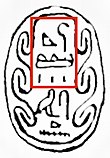Semqen
Semqen (also Šamuqēnu) was an Hyksos ruler of Lower Egypt during the Second Intermediate Period in the mid-17th century BC. According to Jürgen von Beckerath he was the third king of the 16th Dynasty and a vassal of the Hyksos kings of the 15th Dynasty.[4][5] This opinion was shared by William C. Hayes and Wolfgang Helck but recently rejected by Kim Ryholt. In his 1997 study of the Second Intermediate Period, Ryholt argues that the kings of the 16th Dynasty ruled an independent Theban realm c. 1650–1580 BC.[6] Consequently, Ryholt sees Semqen as an early Hyksos king of the 15th Dynasty, perhaps its first ruler. This analysis has convinced some Egyptologists, such as Darrell Baker and Janine Bourriau,[7][8] but not others including Stephen Quirke.[9]
| Semqen | |||||||||||
|---|---|---|---|---|---|---|---|---|---|---|---|
| Šamuqēnu, Sem-qen | |||||||||||
 | |||||||||||
| Heka-chasut | |||||||||||
| Reign | some time between 1649 BC and 1621 BC (Ryholt) (uncertain dynasty, most likely 15th Dynasty, otherwise 16th Dynasty) | ||||||||||
| Predecessor | founder of the dynasty (Ryholt) or 'Aper-'Anati (von Beckerath) | ||||||||||
| Successor | uncertain, 'Aper-'Anati (Ryholt) or Sakir-Har (von Beckerath) | ||||||||||
| |||||||||||
Attestations
Semqen's only contemporary attestation is a brown steatite scarab-seal from Tell el-Yahudiyeh in the Nile Delta.[10] Significantly, the seal gives him the title of Heka-chasut, "Ruler of the foreign lands", a title exclusively associated with the early Hyksos rulers.[1][11] Furthermore, the design of the seal indicates that it was likely produced either during the 14th or the 15th Dynasty, the latter being much more probable.

The original location of the seal, the title it is inscribed with and its design led Ryholt to propose that Semqen belonged to the early 15th Dynasty, although he also points to the conjectural nature of this proposition. Ryholt further adds that the title Heka-chasut, even if securely dated to the 15th Dynasty, may not have been borne only by the rulers of this dynasty.[7]
Once belonging to the Fraser collection,[1] the scarab seal is currently part of a private collection.[10]
References
- Fraser, G.W., A catalogue of scarabs belonging to George Fraser (cat. no. 179). London, Bernard Quaritch, 1900.
- Percy E. Newberry: Scarabs an introduction to the study of Egyptian seals and signet rings, with forty-four plates and one hundred and sixteen illustrations in the text, 1906, available online copyright-free see plate XXIII, num 10 and page 152.
- Percy E. Newberry: Scarabs an introduction to the study of Egyptian seals and signet rings, with forty-four plates and one hundred and sixteen illustrations in the text, 1906, available online copyright-free see plate XXIII, num 10 and page 152.
- Jürgen von Beckerath: Handbuch der ägyptischen Königsnamen, Münchner ägyptologische Studien, Heft 49, Mainz : P. von Zabern, 1999, ISBN 3-8053-2591-6, available online see p. 120–121.
- William C. Hayes, The Cambridge Ancient History (Fascicle): 6: Egypt: From the Death of Ammenemes III to Seqenenre II, CUP Archive, 1962 p 19
- K.S.B. Ryholt: The Political Situation in Egypt during the Second Intermediate Period, c.1800–1550 BC, Carsten Niebuhr Institute Publications, vol. 20. Copenhagen: Museum Tusculanum Press, 1997, excerpts available online here.
- Darrell D. Baker: The Encyclopedia of the Pharaohs: Volume I - Predynastic to the Twentieth Dynasty 3300–1069 BC, Stacey International, ISBN 978-1-905299-37-9, 2008, p. 378
- Janine Bourriau, Ian Shaw (editor): The Oxford history of ancient Egypt, chapter The Second Intermediate Period, Oxford University Press, Oxford 2003, ISBN 0-19-280458-8,
- Stephen Quirke, Marcel Maree (editor): The Second Intermediate Period Thirteenth - Seventeenth Dynasties, Current Research, Future Prospects, Leuven 2011, Paris — Walpole, MA. ISBN 978-9042922280, p. 56, n. 6
- Olga Tufnell: Studies on Scarab Seals Vol. 2, Aris & Phillips 1984, ISBN 978-0856681301, see seal num. 3463 and pl. LXII, p. 382.
- Sir William Matthew Flinders Petrie: Egypt and Israel, London: Society for Promoting Christian Knowledge, 1911, available online copyright-free